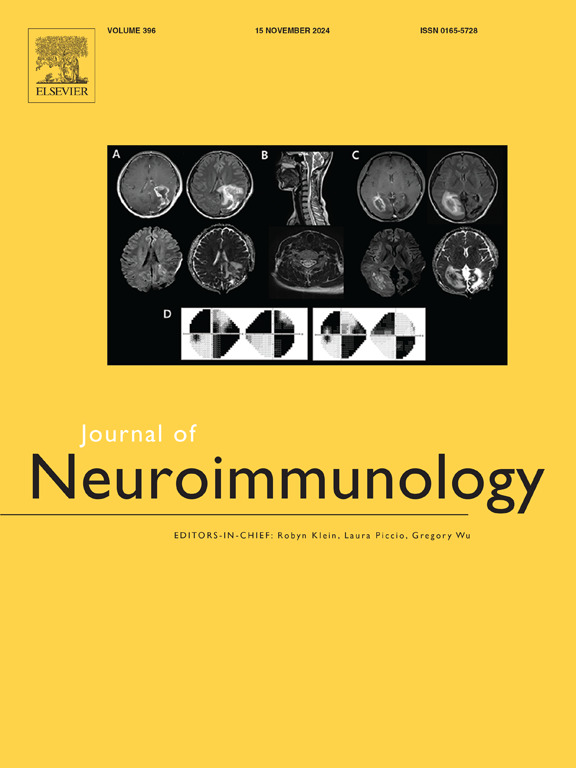Therapeutic potential of Baicalin against experimental obsessive compulsive disorder: Evidence from CSF, blood plasma, and brain analysis
IF 2.9
4区 医学
Q3 IMMUNOLOGY
引用次数: 0
Abstract
Obsessive-Compulsive Disorder (OCD) is a complex neuropsychiatric condition characterized by recurrent obsessions and compulsions, significantly impacting an individual's functionality and quality of life. This study aimed to explore the neuroprotective and therapeutic potential of baicalin, a flavonoid with known antioxidant, anti-inflammatory, and neurotropic properties, in an animal model of OCD induced by 8-OH-DPAT (8HPAT). The research utilized in silico docking studies and in vivo experiments to assess baicalin's interactions with key intracellular targets: SIRT-1, Nrf2, HO-1, and PPAR-gamma, and its effects on neurochemical, neurobehavioral, and histopathological parameters. In silico results indicated a strong binding affinity of baicalin for SIRT-1, Nrf2, HO-1, and PPAR-gamma, suggesting potential regulatory roles in antioxidant and anti-inflammatory pathways. In-vivo findings demonstrated that baicalin, administered at doses of 50 mg/kg and 100 mg/kg, significantly alleviated OCD-like behaviours, including excessive lever pressing, marble burying, and compulsive checking. Baicalin treatment normalized serotonin and dopamine levels and reduced glutamate levels in the brain, restoring neurotransmitter balance. Furthermore, baicalin decreased inflammatory cytokines (TNF-alpha and IL-1 beta), improved complete blood count profile, and gross morphological and histopathological alterations by restoring neuronal density and cellular integrity in affected brain regions. Combining baicalin with fluvoxamine (10 mg/kg) showed synergistic effects, further enhancing neuroprotective outcomes. These results suggest that baicalin holds promise as a potential therapeutic agent for OCD, warranting further clinical investigation to explore its efficacy and underlying mechanisms in human subjects. The findings underscore the importance of targeting intracellular pathways and neurotransmitter systems in developing effective treatments for OCD and related neuropsychiatric disorders.

黄芩苷对实验性强迫症的治疗潜力:来自脑脊液、血浆和脑分析的证据
强迫症(OCD)是一种复杂的神经精神疾病,以反复发作的强迫和强迫为特征,严重影响个人的功能和生活质量。黄芩苷是一种具有抗氧化、抗炎和嗜神经特性的黄酮类化合物,本研究旨在探讨黄芩苷对8-OH-DPAT (8HPAT)诱导的强迫症动物模型的神经保护和治疗作用。本研究通过硅对接研究和体内实验,评估了黄芩苷与细胞内关键靶点SIRT-1、Nrf2、HO-1和ppar - γ的相互作用及其对神经化学、神经行为和组织病理学参数的影响。结果表明黄芩苷对SIRT-1、Nrf2、HO-1和ppar - γ具有很强的结合亲和力,提示其在抗氧化和抗炎途径中具有潜在的调节作用。体内实验结果表明,给药剂量为50 mg/kg和100 mg/kg的黄芩苷可显著缓解强迫症样行为,包括过度按压杠杆、掩埋大理石和强迫性检查。黄芩苷治疗使大脑中血清素和多巴胺水平正常化,降低谷氨酸水平,恢复神经递质平衡。此外,黄芩苷降低炎症细胞因子(tnf - α和IL-1 β),改善全血细胞计数,并通过恢复受影响脑区域的神经元密度和细胞完整性来改善大体形态学和组织病理学改变。黄芩苷与氟伏沙明(10 mg/kg)联用显示协同效应,进一步增强神经保护效果。这些结果表明黄芩苷有望成为治疗强迫症的潜在药物,值得进一步的临床研究来探索其在人类受试者中的疗效和潜在机制。这些发现强调了针对细胞内通路和神经递质系统开发有效治疗强迫症和相关神经精神疾病的重要性。
本文章由计算机程序翻译,如有差异,请以英文原文为准。
求助全文
约1分钟内获得全文
求助全文
来源期刊

Journal of neuroimmunology
医学-免疫学
CiteScore
6.10
自引率
3.00%
发文量
154
审稿时长
37 days
期刊介绍:
The Journal of Neuroimmunology affords a forum for the publication of works applying immunologic methodology to the furtherance of the neurological sciences. Studies on all branches of the neurosciences, particularly fundamental and applied neurobiology, neurology, neuropathology, neurochemistry, neurovirology, neuroendocrinology, neuromuscular research, neuropharmacology and psychology, which involve either immunologic methodology (e.g. immunocytochemistry) or fundamental immunology (e.g. antibody and lymphocyte assays), are considered for publication.
 求助内容:
求助内容: 应助结果提醒方式:
应助结果提醒方式:


